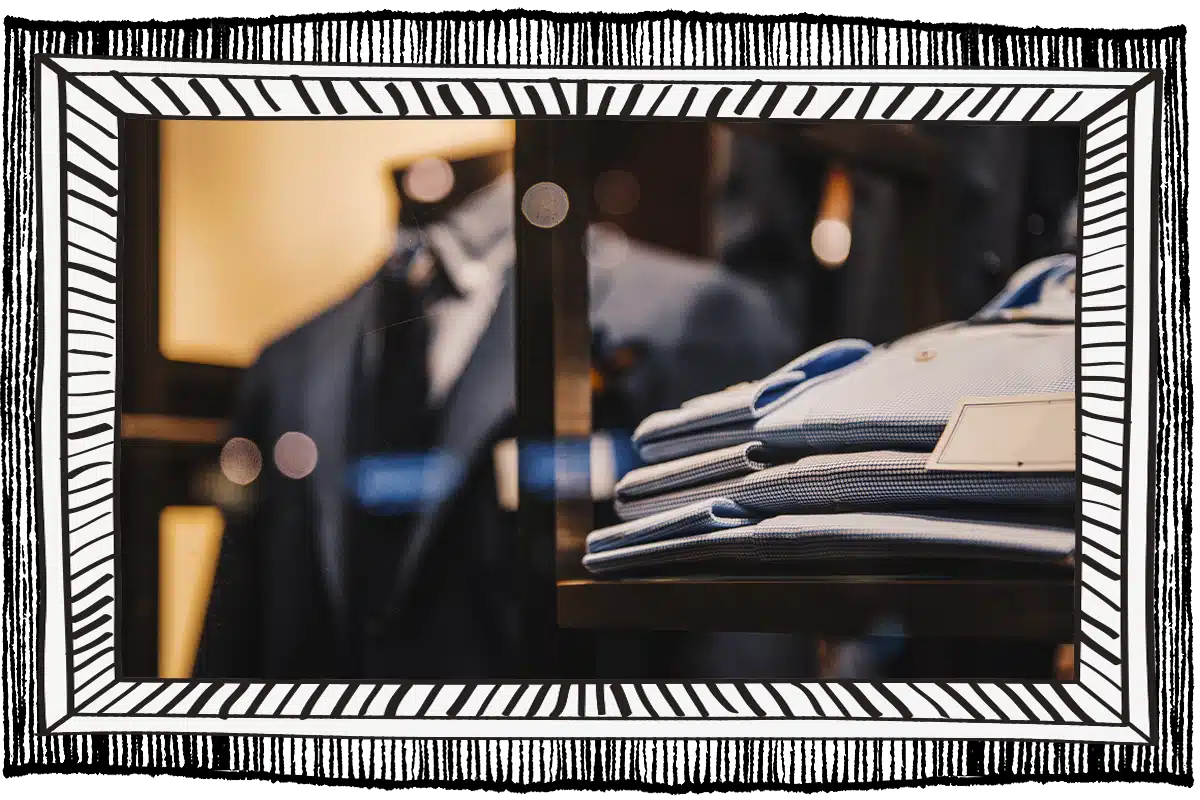Comfort, style, and quality – is it possible to have all three when choosing a men’s shirt ?
Ideally, a shirt should be versatile and easily complement your wardrobe. However, there’s nothing wrong with owning a few less casual pieces for special occasions.
To choose the right shirt, there are several essential criteria to consider:
- Fit : Determined by your body shape and the style you’re aiming for.
- Fabric : The material of the shirt.
- Details (which are crucial) : The collar, cuffs, and sleeve length.
We’ll guide you in selecting the best pieces for your shirt collection.
Fit to sculpt, details to add personality
As you may already know, while the choice of fabric is crucial for conveying the quality of a garment, the fit is equally important. These two aspects work together to create the best drape, generating fluidity, volume, and movement. Therefore, the choice of your shirt’s fit will be vital to highlight and flatter your silhouette.
Shirt fit and adjustment
A shirt tailor will take measurements of your waist, chest, neck, shoulder width, and back length. Whether you opt for made-to-measure or bespoke tailoring, you will get a perfectly fitted shirt with high-quality finishes. Men tend to choose shirts slightly too loose to allow for good freedom of movement.
Find in this article the most prestigious addresses to have your shirt made to measure in Paris.
If you choose a ready-to-wear men’s shirt, pay close attention to its fit. Just like with a custom-made shirt, to ensure good freedom of movement, choose your shirt one size larger. Some models suit certain body types better; you can get advice in-store. Here are some fit options :
- Fitted or tailored fit : Elegant and modern, this fit is suitable for men without excess weight.
- Slim fit : Very close to the body, to highlight what should be emphasized.
- Classic or straight fit : Helps to streamline the silhouette.
- Loose fit : Ideal for casual shirts.
Collar, sleeves, cuffs, and their buttons
You can match the style of your shirt’s collar with the cuffs. Choose your collar based on the accessories you wish to pair it with, such as a tie, bow tie, etc.
- Ceremonial Shirt : Opt for a French cuff shirt, preferably in white, with cufflinks or mousquetaire cuffs, and a wing collar for the bow tie. Naturally, the suit should complement the elegance of the shirt.
- Work Shirt : A French collar or button-down collar allows for a tie, but it’s not mandatory—it depends on your preferences and style. Sometimes, the suit itself can highlight the shirt without any accessory. In such cases, an English collar provides the necessary formality for a professional outfit.
- Shirt Without a Tie : A Mandarin collar or an open button-down collar works well. A simple square cuff is sufficient here.
Choosing fabric based on season and shirt usage
Tailors are constantly innovating, offering increasingly original fabrics. However, not all these options are within reach for everyone. Here is a non-exhaustive list, from the most common to the most extravagant fabrics.
Winter shirts
- Cotton Poplin: High-quality poplin is usually woven from cotton fibers. It is a very tight weave, giving the fabric a smooth and silky appearance. Breathable, poplin allows for easy maintenance and makes ironing simple. Poplin shirts can be plain or patterned and are perfect for daily wear in a sophisticated work environment, making them a formal shirt choice.
- Oxford Fabric: Oxford shirts are better suited for winter due to their thicker texture. It’s still cotton for high quality, though it can also be blended with polyester. The drape is casual, making it ideal for a relaxed shirt or an overshirt.
- Flannel: Made from cotton or wool, flannel shirts are definitely for winter. The velvet-like weave gives it a soft and plush appearance, making it perfect for wearing by the fire in a casual setting.
- Chambray: Made from linen or cotton, chambray is woven with differently colored threads, giving it a heathered look. It’s a casual fabric, great for a natural, sporty look.
Summer shirts
- Linen: Known for its natural fibers, linen wrinkles quickly. However, it remains a timeless choice for dining by the water or sightseeing in high temperatures. To minimize wrinkles, linen is often blended with polyester, elastane, or viscose, though this compromises its light and airy drape.
- Silk: This animal-derived fiber is a high-end material with incredible benefits: thermoregulation, breathability, and strength despite its lightness and flexibility. Silk absorbs colors well, allowing for vibrant, extravagant patterns. A silk shirt is eternally a symbol of refinement and elegance, making it a dressy option.
- Lyocell: The only fabric here that isn’t natural, though not synthetic either. Made from wood pulp transformed into cellulose and then into fiber, it is a more eco-friendly process than that of viscose. Lyocell has excellent characteristics and can be blended with silk or linen to make them less prone to wrinkling.
A quality shirt starts with the quality of the warp and weft threads, ensuring a durable fabric that lives up to its promises. Learn to recognize this quality by touch.
Some ideas for pairing your shirt
For a man with impeccable taste, having a beautiful shirt is not enough: it must be paired with the right outfit. For example, an Oxford checkered shirt should not be worn with pleated trousers. If you are unsure, seek advice from your tailor or in-store experts.
In the meantime, here are some tips.
Pairing an oxford shirt
Add some zest to a casual Oxford shirt with raw denim jeans or chinos. Pair the chinos with a tweed blazer for an elegant touch, and complete the look with white sneakers.
For a more rugged style, choose a leather jacket with jeans. Complement this combination with a denim shirt and suede boots.
Formal poplin shirt
Ideally, wear it with a suit. This shirt is designed for the office or understated occasions. The suit style will be crucial, making the shirt a secondary feature. Pair it with Derby or Oxford shoes.
Explore different sartorial styles to learn more about various suit cuts, from English to Italian and Japanese.
Linen or silk shirt
Adapt the look to the summer season: lightweight chinos or linen trousers will give an Italian style. The jacket should not be fitted or too structured; a loose blazer will be perfect. For shoes, loafers are an excellent choice.
Having a variety of shirts in your wardrobe ensures an impeccable style. Standing out among men in jeans and polos or t-shirts and vests becomes easy with a beautiful suit, dress trousers, and even a classic shirt. However, it must be done with elegance, and your critical eye on details like buttons and stitching will elevate you to the rank of a connoisseur.

